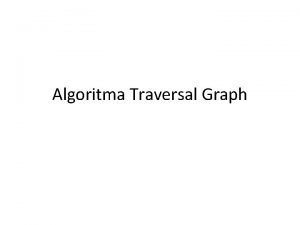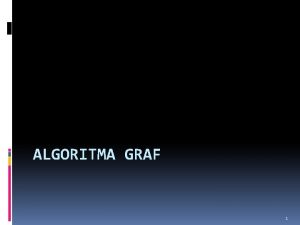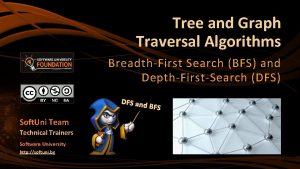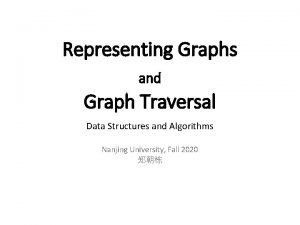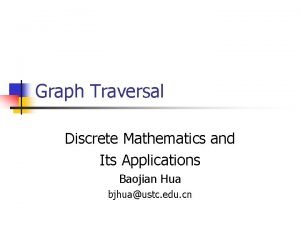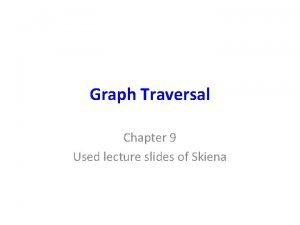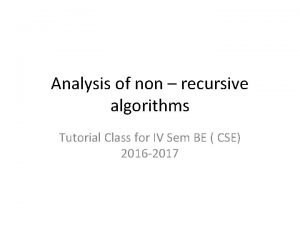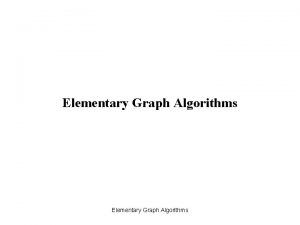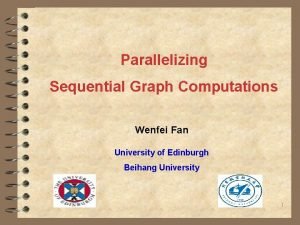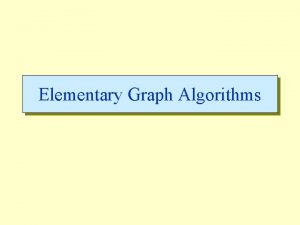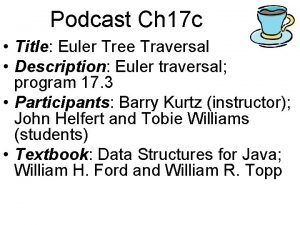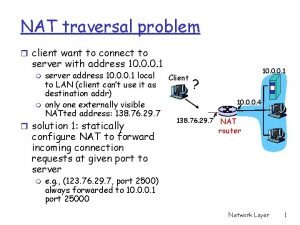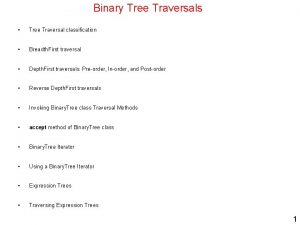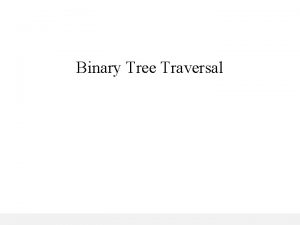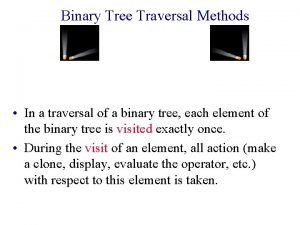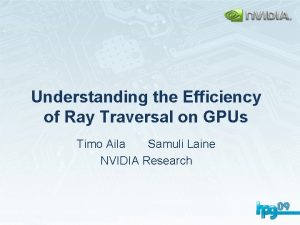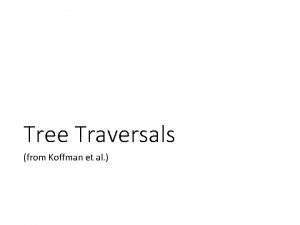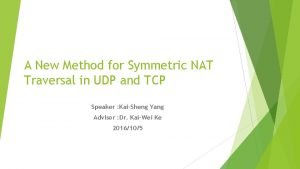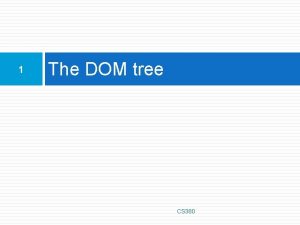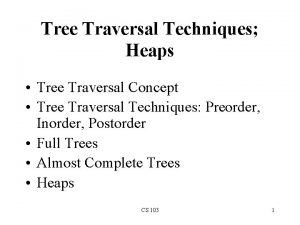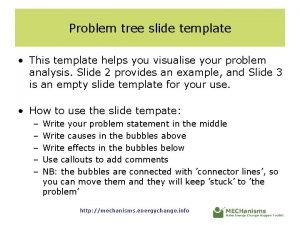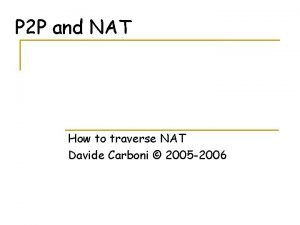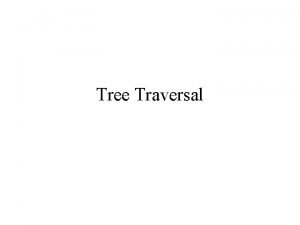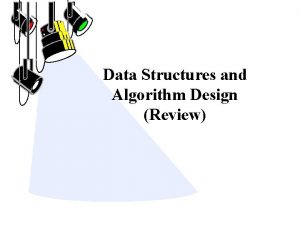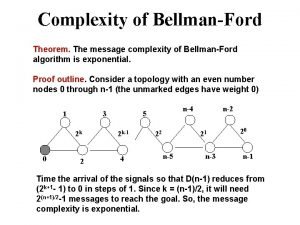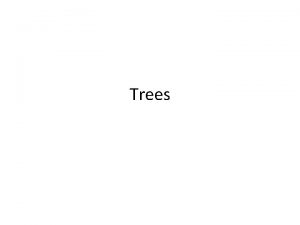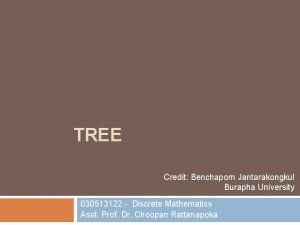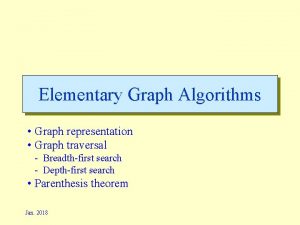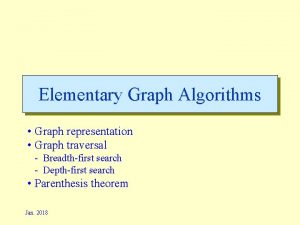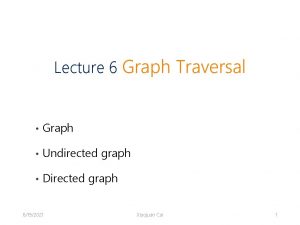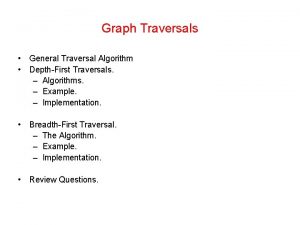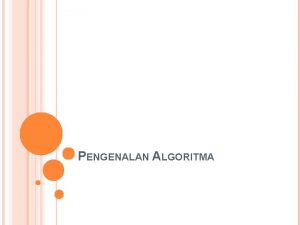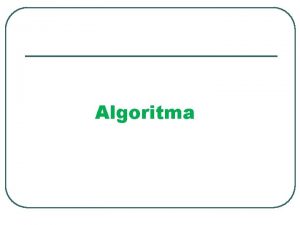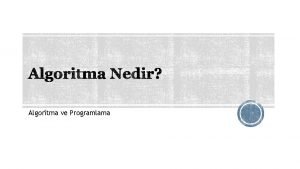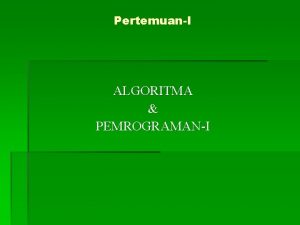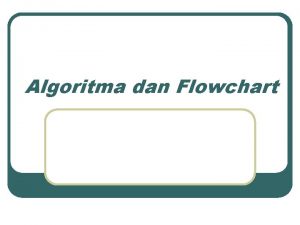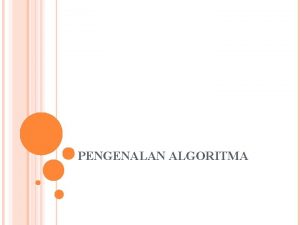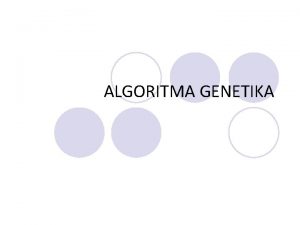Algoritma Traversal Graph Graph Traversal Algorithms In general






































- Slides: 38

Algoritma Traversal Graph

Graph Traversal Algorithms • In general, graphs do not have a vertex, like a root, that initiates unique paths to each of the vertices. From any starting vertex in a graph, it might not be possible to search all of the vertices. In addition, a graph could have a cycle that results in multiple visits to a vertex. © 2005 Pearson Education, Inc. , Upper Saddle River, NJ. All rights reserved.

Graph Traversal Algorithms (continued) • The breadth-first search visits vertices in the order of their path length from a starting vertex. It may not visit every vertex of the graph • The depth-first search traverses all the vertices of a graph by making a series of recursive calls that follow paths through the graph. © 2005 Pearson Education, Inc. , Upper Saddle River, NJ. All rights reserved.

Graph Traversal Algorithms (continued) • Graph algorithms discern the state of a vertex during the algorithm by using the colors WHITE, GRAY, and BLACK. © 2005 Pearson Education, Inc. , Upper Saddle River, NJ. All rights reserved.

Breadth-First Search Algorithm © 2005 Pearson Education, Inc. , Upper Saddle River, NJ. All rights reserved.

Breadth-First Search Algorithm (continued) • Color all vertices of the sample graph WHITE and push the starting vertex (A) onto the queue visit. Queue. • Pop A from the queue, color it BLACK, and insert it into visit. List, which is the list of visited vertices. Push all WHITE neighbors onto the queue. © 2005 Pearson Education, Inc. , Upper Saddle River, NJ. All rights reserved.

Breadth-First Search Algorithm (continued) • Pop B from the queue and place it in visit. List with color BLACK. The only adjacent vertex for B is D, which is still colored WHITE. Color D GRAY and add it to the queue © 2005 Pearson Education, Inc. , Upper Saddle River, NJ. All rights reserved.

Breadth-First Search Algorithm (continued) • Pop C and place it in visit. List. The adjacent vertex G is GRAY. No new vertices enter the queue. © 2005 Pearson Education, Inc. , Upper Saddle River, NJ. All rights reserved.

Breadth-First Search Algorithm (continued) • Pop vertex G from the queue and place it in visit. List. G has no adjacent vertices, so pop D from the queue. The neighbors, E and F, enter the queue. © 2005 Pearson Education, Inc. , Upper Saddle River, NJ. All rights reserved.

Breadth-First Search Algorithm (continued) • Continue in this fashion until the queue is empty. © 2005 Pearson Education, Inc. , Upper Saddle River, NJ. All rights reserved.

Implementing Breadth-First Search • Define public enum Vertex. Color { WHITE, GRAY, BLACK } © 2005 Pearson Education, Inc. , Upper Saddle River, NJ. All rights reserved.

Implementing Breadth-First Search (continued) • The Di. Graph class declares three methods that access and update the color attribute of a vertex. © 2005 Pearson Education, Inc. , Upper Saddle River, NJ. All rights reserved.

Implementing Breadth-First Search (continued) • The method bfs() returns a list of vertices visited during the breadth‑first search from a starting vertex. © 2005 Pearson Education, Inc. , Upper Saddle River, NJ. All rights reserved.

bfs() // perform the breadth-first traversal // from s. Vertex and return the list // of visited vertices public static <T> Linked. List<T> bfs( Di. Graph<T> g, T s. Vertex) { // queue stores adjacent vertices; list // stores visited vertices Linked. Queue<T> visit. Queue = new Linked. Queue<T>(); Linked. List<T> visit. List = new Linked. List<T>(); // set and iterator retrieve and scan // neighbors of a vertex Set<T> edge. Set; Iterator<T> edge. Iter; T curr. Vertex = null, neighbor. Vertex = null; © 2005 Pearson Education, Inc. , Upper Saddle River, NJ. All rights reserved.

bfs() (continued) // check that starting vertex is valid if (!g. contains. Vertex(s. Vertex)) throw new Illegal. Argument. Exception( "bfs(): starting vertex not in the graph"); // color all vertices WHITE g. color. White(); // initialize queue with starting vertex visit. Queue. push(s. Vertex); while (!visit. Queue. is. Empty()) { // remove a vertex from the queue, color // it black, and add to the list of // visited vertices curr. Vertex = visit. Queue. pop(); g. set. Color(curr. Vertex, Vertex. Color. BLACK); visit. List. add(curr. Vertex); © 2005 Pearson Education, Inc. , Upper Saddle River, NJ. All rights reserved.

bfs() (continued) // obtain the set of neighbors for current vertex edge. Set = g. get. Neighbors(curr. Vertex); // sequence through the neighbors and look // for vertices that have not been visited edge. Iter = edge. Set. iterator(); while (edge. Iter. has. Next()) { neighbor. Vertex = edge. Iter. next(); © 2005 Pearson Education, Inc. , Upper Saddle River, NJ. All rights reserved.

bfs() (concluded) if (g. get. Color(neighbor. Vertex) == Vertex. Color. WHITE) { // color unvisited vertex GRAY and // push it onto queue g. set. Color(neighbor. Vertex, Vertex. Color. GRAY); visit. Queue. push(neighbor. Vertex); } } } return visit. List; } © 2005 Pearson Education, Inc. , Upper Saddle River, NJ. All rights reserved.

bfs() (concluded) if (g. get. Color(neighbor. Vertex) == Vertex. Color. WHITE) { // color unvisited vertex GRAY and // push it onto queue g. set. Color(neighbor. Vertex, Vertex. Color. GRAY); visit. Queue. push(neighbor. Vertex); } } } return visit. List; } © 2005 Pearson Education, Inc. , Upper Saddle River, NJ. All rights reserved.

Running Time of Breadth-First Search • The running time for the breadth-first search is O(V + E), where V is the number of vertices and E is the number of edges. © 2005 Pearson Education, Inc. , Upper Saddle River, NJ. All rights reserved.

Breadth-First Search Example // create a graph g and declare start. Vertex and visit. List Di. Graph<String> g = Di. Graph. read. Graph("bfsgraph. dat"); String start. Vertex; List<String> visit. List; . . . // call bfs() with arguments g and start. Vertx visit. List = Di. Graphs. bfs(g, start. Vertex); // output the visit. List System. out. println("BFS visit. List from " + start. Vertex + ": " + visit. List); © 2005 Pearson Education, Inc. , Upper Saddle River, NJ. All rights reserved.

Breadth-First Search Example (concluded) Output: Run 1: (start. Vertex = "A") BFS visit. List from A: Run 2: (start. Vertex = "D") BFS visit. List from D: Run 3: (start. Vertex = "E") BFS visit. List from E: © 2005 Pearson Education, Inc. , Upper Saddle River, NJ. All rights reserved. [A, G, B, C, D, E, F] [D, E, F, G] [E]

Depth-First Visit • The depth-first visit algorithm is modeled after the recursive postorder scan of a binary tree. In the tree, a node is visited only after visits are made to all of the nodes in its subtree. In the graph, a node is visited only after visiting all of the nodes in paths that emanate from the node. © 2005 Pearson Education, Inc. , Upper Saddle River, NJ. All rights reserved.

Depth-First Visit (continued) • Backtrack to the previous recursive step and look for another adjacent vertex and launch a scan down its paths. There is no ordering among vertices in an adjacency list, so the paths and hence the order of visits to vertices can vary. © 2005 Pearson Education, Inc. , Upper Saddle River, NJ. All rights reserved.

• • • Depth-First Visit (continued) Discover A (color GRAY) Discover B (color GRAY) Discover D (color GRAY) Discover E (color GRAY, then BLACK) Backtrack D (color BLACK) Backtrack B (color BLACK) Backtrack A (A remains GRAY) Discover C (color BLACK) Backtrack A (color BLACK). Visit complete. © 2005 Pearson Education, Inc. , Upper Saddle River, NJ. All rights reserved.

Depth-First Visit (continued) • The depth‑first visit is a recursive algorithm that distinguishes the discovery and finishing time (when a vertex becomes BLACK) of a vertex. • The depth‑first visit returns a list of the vertices found in the reverse order of their finishing times. © 2005 Pearson Education, Inc. , Upper Saddle River, NJ. All rights reserved.

Depth-First Visit (continued) • An edge that connects a vertex to a neighbor that has color GRAY is called a back edge. – A depth-first visit has a cycle if and only if it has a back edge. © 2005 Pearson Education, Inc. , Upper Saddle River, NJ. All rights reserved.

dfs. Visit() // depth-first visit assuming a WHITE starting // vertex; dfs. List contains the visited vertices in // reverse order of finishing time; when check. For. Cycle // is true, throws Illegal. Path. State. Exception if it // detects a cycle public static <T> void dfs. Visit(Di. Graph<T> g, T s. Vertex, Linked. List<T> dfs. List, boolean check. For. Cycle) { T neighbor. Vertex; Set<T> edge. Set; // iterator to scan the adjacency set of a vertex Iterator<T> edge. Iter; Vertex. Color color; if (!g. contains. Vertex(s. Vertex)) throw new Illegal. Argument. Exception( "dfs. Visit(): vertex not in the graph"); © 2005 Pearson Education, Inc. , Upper Saddle River, NJ. All rights reserved.

dfs. Visit() (continued) // color vertex GRAY to note its discovery g. set. Color(s. Vertex, Vertex. Color. GRAY); edge. Set = g. get. Neighbors(s. Vertex); // sequence through the adjacency set and look // for vertices that are not yet discovered // (colored WHITE); recursively call dfs. Visit() // for each such vertex; if a vertex in the adjacency // list is GRAY, the vertex was discovered during a // previous call and there is a cycle that begins and // ends at the vertex; if check. For. Cycle is true, // throw an exception edge. Iter = edge. Set. iterator(); © 2005 Pearson Education, Inc. , Upper Saddle River, NJ. All rights reserved.

dfs. Visit() (concluded) while (edge. Iter. has. Next()) { neighbor. Vertex = edge. Iter. next(); color = g. get. Color(neighbor. Vertex); if (color == Vertex. Color. WHITE) dfs. Visit(g, neighbor. Vertex, dfs. List, check. For. Cycle); else if (color == Vertex. Color. GRAY && check. For. Cycle) throw new Illegal. Path. State. Exception( "dfs. Visit(): graph has a cycle"); } // finished with vertex s. Vertex; make it BLACK // and add it to the front of dfs. List g. set. Color(s. Vertex, Vertex. Color. BLACK); dfs. List. add. First(s. Vertex); } © 2005 Pearson Education, Inc. , Upper Saddle River, NJ. All rights reserved.

Depth-First Visit Example Linked. List<String> finish. Order = new Linked. List<String>(); g. color. White(); Di. Graphs. dfs. Visit(g, "B", finish. Order, false); Output: finish. Order: [B, D, E, F, C] © 2005 Pearson Education, Inc. , Upper Saddle River, NJ. All rights reserved.

Depth-First Visit Example (concluded) finish. Order = new Linked. List<String>(); g. color. White(); try { Di. Graphs. dfs. Visit(g, "E", finish. Order, true); System. out. println("finish. Order: " + finish. Order); } catch (Illegal. Path. State. Exception ipse) { System. out. println(ipse. get. Message()); } Output: dfs. Visit(): cycle involving vertices D and E © 2005 Pearson Education, Inc. , Upper Saddle River, NJ. All rights reserved.

Depth-First Search Algorithm • Depth‑first search begins with all WHITE vertices and performs depth‑first visits until all vertices of the graph are BLACK. • The algorithm returns a list of all vertices in the graph in the reverse order of their finishing times. © 2005 Pearson Education, Inc. , Upper Saddle River, NJ. All rights reserved.

dfs() // depth-first search; dfs. List contains all // the graph vertices in the reverse order // of their finishing times public static <T> void dfs(Di. Graph<T> g, Linked. List<T> dfs. List) { Iterator<T> graph. Iter; T vertex = null; // clear dfs. List. clear(); // initialize all vertices to WHITE g. color. White(); © 2005 Pearson Education, Inc. , Upper Saddle River, NJ. All rights reserved.

dfs() (concluded) // call dfs. Visit() for each WHITE vertex graph. Iter = g. vertex. Set(). iterator(); while (graph. Iter. has. Next()) { vertex = graph. Iter. next(); if (g. get. Color(vertex) == Vertex. Color. WHITE) dfs. Visit(g, vertex, dfs. List, false); } } © 2005 Pearson Education, Inc. , Upper Saddle River, NJ. All rights reserved.

Running Time for Depth-First Search • An argument similar to that for the breadthfirst search shows that the running time for dfs() is O(V+E), where V is the number of vertices in the graph and E is the number of edges. © 2005 Pearson Education, Inc. , Upper Saddle River, NJ. All rights reserved.

Depth-First Search Example dfs. Visit() starting at E followed by dfs. Visit() starting at A dfs. List: [A, B, C, E, F, G, D] © 2005 Pearson Education, Inc. , Upper Saddle River, NJ. All rights reserved.

Program 24. 2 import java. io. File. Not. Found. Exception; import ds. util. Di. Graphs; public class Program 24_2 { public static void main(String[] args) throws File. Not. Found. Exception { Di. Graph<String> g = Di. Graph. read. Graph("cycle. dat"); // determine if the graph is acyclic if (Di. Graphs. acyclic(g)) System. out. println("Graph is acyclic"); else System. out. println("Graph is not acyclic"); © 2005 Pearson Education, Inc. , Upper Saddle River, NJ. All rights reserved.

Program 24. 2 (concluded) // add edge (E, B) to create a cycle System. out. print(" Adding edge (E, B): "); g. add. Edge("E", "B", 1); // retest the graph to see if it is acyclic if (Di. Graphs. acyclic(g)) System. out. println("New graph is acyclic"); else System. out. println("New graph is not acyclic"); } } Run: Graph is acyclic Adding edge (E, B): New graph is not acyclic © 2005 Pearson Education, Inc. , Upper Saddle River, NJ. All rights reserved.
 Algoritma traversal
Algoritma traversal Algoritma graf
Algoritma graf Algoritma traversal adalah
Algoritma traversal adalah Bfs tree
Bfs tree Graph traversal in data structure
Graph traversal in data structure Graph traversal in discrete mathematics
Graph traversal in discrete mathematics Graph traversal methods
Graph traversal methods Summarize the general plan for non-recursive algorithms.
Summarize the general plan for non-recursive algorithms. Topological sort演算法
Topological sort演算法 Parallelizing sequential graph computations
Parallelizing sequential graph computations W graph
W graph Undirected graph algorithms
Undirected graph algorithms Planos en cinematografia
Planos en cinematografia Where did general lee surrender to general grant?
Where did general lee surrender to general grant? Traversal wave
Traversal wave Euler tree
Euler tree Nat traversal problem solution
Nat traversal problem solution Iterative inorder
Iterative inorder Breadth first
Breadth first Lcr is related to which tree traversal
Lcr is related to which tree traversal Binary tree traversal techniques
Binary tree traversal techniques Huffman tree traversal
Huffman tree traversal Understanding the efficiency of ray traversal on gpus
Understanding the efficiency of ray traversal on gpus Tree traversal visualization
Tree traversal visualization Nat mode symmetric or cone
Nat mode symmetric or cone Dom tree
Dom tree Concept tree
Concept tree Tree traversal
Tree traversal Problem statement slide
Problem statement slide Simple traversal of udp through nat
Simple traversal of udp through nat Bfs traversal
Bfs traversal Pre order traversal
Pre order traversal Bfs tree traversal
Bfs tree traversal Tree traversal in data structure
Tree traversal in data structure Bellmanford
Bellmanford Session traversal utilities for nat
Session traversal utilities for nat Postorder traversal abdchgfe
Postorder traversal abdchgfe Binary tree adt
Binary tree adt Post order traversal
Post order traversal
